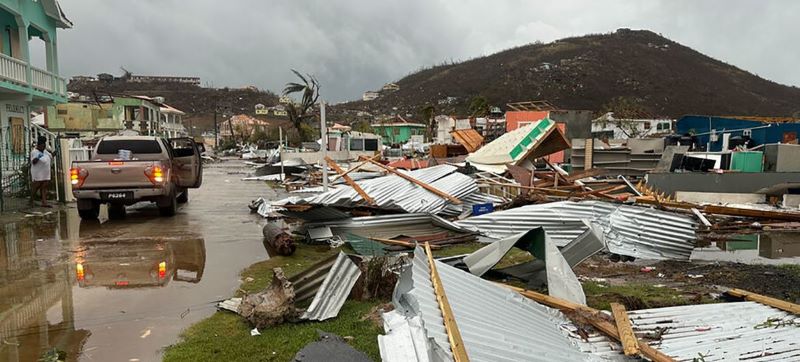 Hurricane Beryl
Hurricane Beryl
UN official describes total devastation in Carriacou following Hurricane Beryl
The island of Carriacou in Grenada has been virtually “flattened” by the devastating Hurricane Beryl, a senior UN official there reported on Friday, as humanitarian teams ramp up their support to communities affected across the Caribbean.
Speaking via video link from Grenada, Simon Springett, UN Resident Coordinator in Barbados and the Eastern Caribbean, outlined a scene of total devastation in Carriacou – where Beryl first made landfall on 1 July.
“The entire island is completely affected … that is literally 100 per cent of the population,” he stressed.
Hurricane Beryl is the strongest hurricane in history to form in June in the Atlantic Ocean. Initially a tropical depression, it rapidly intensified into a Category 4 storm and briefly reached Category 5 status, with winds up to 240 km/h (150 mph).
On Friday morning (New York time), it made landfall in Mexico’s Yucatán Peninsula, and is reportedly tracking west-northwest, projected to make landfall in southern Texas, United States on Monday morning.
‘Very complicated crisis’
Springett highlighted the situation as a “very complicated crisis”, one that is marked by severe logistical and access challenges.
Four days after the hurricane hit, roads on the island are impassable and communications were only restored last night, he said.
“Directly after the hurricane, the seas were exceptionally rough, which made it nearly impossible to get there. The air control towers are out – so there is only fly by visibility. But also, even when things get to the airport, there no roads to access the goods.”
International response
Nations near and far are dispatching aid, with a French ship arriving in Carriacou later in the day as well as assistance from Guyana, and Trinidad and Tobago, Mr. Springett said.
“We have a large outpouring of international response … it is really an international effort, and the UN is really proud to be to be a part of this,” he said.
Also speaking, via video link from Bahamas, Dennis Zulu, the Resident Coordinator for Jamaica and Bahamas, echoed international collaboration.
He highlighted that the UN is working in coordination with Caribbean Disaster Emergency Management Agency (CDEMA), the regional emergency and disaster response agency to ensure a coherent regional response.
“We are poised to mount a coordinated humanitarian response with the international development partner community and are already engaging international partners and organizations in Jamaica,” he added.
Widespread damage
Detailed assessment of damage in Jamaica and in other island nations supported by his office are ongoing, Mr. Zulu said.
“The damage is widely apparent and is felt by people from all walks of life, especially in rural Jamaica, including in the southern parishes of Clarendon, Manchester and Saint Elizabeth, and for those in vulnerable housing,” he added.
He also noted that the Government of Jamaica has put in place an effective response plan, supported by UN and partners, including shelters for those who lost their homes.
Alongside, other key requirements include clean drinking water, access to communication and data and livelihood support.
‘Pledge to be there for children’
According to the UN Children’s Fund (UNICEF), over 650,000 people – including 150,000 children – in Barbados, Grenada, Saint Lucia, Saint Vincent and the Grenadines, and Tobago were in the path of Hurricane Beryl.
Many have lost homes and are being housed in temporary shelters.
The UN agency for its part had pre-positioned life-saving supplies before the storm and is mobilizing supplies and funds for the response.
“[We are] deeply concerned at the plight of those affected by Hurricane Beryl, especially the most vulnerable – children and women … we pledge to be there for children of the affected countries,” said Pieter Bult, UNICEF Representative for the Eastern Caribbean Area.
Similarly, the UN World Food Programme (WFP) has also deployed teams to the affected islands, supporting authorities with assessments and early response.
In Saint Vincent and the Grenadines, the agency has been asked to provide emergency telecommunications and logistics support, while in Barbados it is assisting with emergency food kits that will be shipped and distributed to people in the affected islands.
‘Very intense’ hurricane season looms
Earlier in the day in Geneva, Vanessa Huguenin, a spokesperson for the UN Office for the Coordination of Humanitarian Affairs (OCHA), said that while humanitarians have been preparing for this hurricane season, “such a strong storm this early is extremely rare.”
“It is also a warning for the anticipated very intense hurricane season that is coming,” she said at the regular media briefing at the UN Office at Geneva (UNOG).
The Atlantic storm season runs from June through the end of November, with 17 to 25 named storms expected. The average is 14 storms a year.
Of those, the UN World Meteorological Organization (WMO) said that eight to 13 are forecast to become hurricanes – above the average of seven – including four to seven major hurricanes.
A major hurricane is category three, four or five on the Saffir Simpson scale, with winds of 110 mph winds (177 km/h), or higher.
“This new reality of unprecedented hurricanes is becoming an annual and ever-present reality for the Caribbean countries while facing the brunt of climate change,” said Rhea Pierre, Disaster Manager at the International Federation of Red Cross and Red Crescent Societies (IFRC).
“The severity of damages in the aftermath of Hurricane Beryl are tangible and devastating.”
Support Our Journalism
We cannot do without you.. your contribution supports unbiased journalism
IBNS is not driven by any ism- not wokeism, not racism, not skewed secularism, not hyper right-wing or left liberal ideals, nor by any hardline religious beliefs or hyper nationalism. We want to serve you good old objective news, as they are. We do not judge or preach. We let people decide for themselves. We only try to present factual and well-sourced news.







